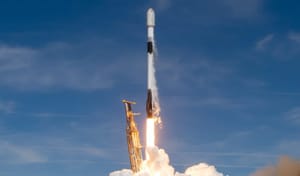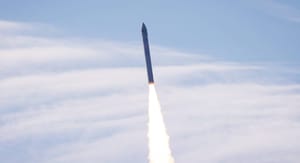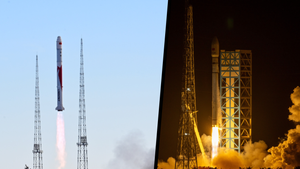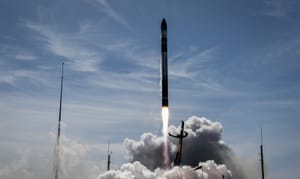
SpaceX launched its twenty-first mission of the year from Space Launch Complex 4E at Vandenberg Space Force Base, in California. The mission was carrying a variety of commercial payloads as part of the Transporter-10 mission.
This launch is part of SpaceX's Transporter dedicated smallsat rideshare program, which aims to offer an affordable launch option for small payloads. The launch is believed to have been carrying fifty-three payloads onboard.

The booster for this mission was B1081 making its fifth flight and landing back at Landing Zone 4 at Vandenberg Space Force Base, in California. The booster has previously supported the Crew-7, CRS-29, Starlink Group 6-34, and PACE missions.
What were the payloads?
Disclaimer: Not all spacecraft onboard have been identified due to their operators not disclosing information.
Tower 5 & 6 - Tower 5 & 6 are two small satellites from Lynk Global. The two satellites are intended to be used for providing cell services from space.
MethaneSAT - Is a spacecraft from MethaneSAT.org, who are subsidiary of the Environmental Defense Fund. The satellite is intended to observe methane emissions from space with the organization providing the data for free to the public.
Gluon - Is a small test satellite by Atomos Nuclear and Space. The spacecraft is intended to work in collaboration with Quark-LITE for rendezvous and a small fuel transfer.
Quark-LITE - Is a small test satellite by Atomos Nuclear and Space. Quark-LITE is intended to attempt a rendezvous with Gluon after which it will dock and refuel from Gluon's tanks.
LizzieSat - LizzieSat is a payload platform for a variety of customers by Sidus Space. The spacecraft for this mission is hosting NASA's Autonomous Satellite Technology for Resilient Application as well as multiple other payloads for other customers.
Jackal - is an autonomous orbital vehicle by True Anomaly. There are believed to be two of these onboard to demonstrate rendezvous and proximity operations.
Aries - Is a demonstrator spacecraft from Apex. The satellite is believed to be the first one of its kind from Apex as it prepares to hand future Aries satellites off to customers.
AEROS - Is a Portuguese CubeSat from CEiiA. The satellite is believed to be a test spacecraft in order to learn how to operate a satellite in space ahead of a planned constellation.
Aerospacelab - Aerospacelab is believed to have four MicroSats onboard of Transporter-10 called Rose, Loulou, Riri, and Fifi. The satellites are believed to be intended for showcasing Very High Resolution and Radio Frequency Sensing payloads.
BRO-12 & 13 - BRO-12 and BRO-13 are two CubeSats from Unseenlabs. The satellites are believed to be for reconnaissance using radio frequency surveillance.
ContecSat-1 - Is a CubeSat from Contec. The satellite is believed to be an Earth observation satellite which will have its date used for detecting changes of urban, vegetation, and coastal areas.
HORACIO - Is a CubeSat from Satlantis. HORACIO is believed to be an Earth observation satellite providing data on agriculture, coastal, and environmental monitoring.
Hubble-1 & 2 - Are believed to be CubeSats built by Spire for Hubble Network. The satellite are believed to support Hubble Networks' goal of connecting one billion devices via Bluetooth technology.
ICEYE X-36, 37, & 38 - Are believed to be three MicroSats from ICEYE. The satellites are believed to be for synthetic-aperture radar observations.
IOD-6 Hammer - Is a CubeSat from Open Cosmos, likely for an Earth observation mission for a customer.
IRIS-F1 - Is a CubeSat built by SATORO Space for the National Cheng Kung University in Taiwan. The satellite is believed to be for a technology demonstration.
LEMUR-2 - Spire is believed to have two LEMUR-2 satellites onboard, the form factor of the satellite was not stated.
MuSat-2 - Is a MicroSat by Muon Space meant to demonstrate and validate the on-orbit performance of Muon Space’s in-house microwave and hyperspectral sensors.
ÑuSat-44 - Is a small satellite from Satellogic. The satellite is believed to be an Earth observation satellite for its already existing constellation.
OrbAstro-TR2 - Is a CubeSat from OrbAstro for an undisclosed customer.
ONDOSAT-OWL-1 & 2 - Is a pair of CubeSats from Mongolian ONDO Space. The satellites are believed to be for technology testing and to serve as a target for amateur operators on amateur UHF band radio antennas.
SONATE-2 - Is believed to be a CubeSat from the Julius-Maximilians-Universität in Würzburg in Germany. The satellite is believed to have AI and imaging payloads onboard.
Veery-0E - Is a CubeSat from Care Weather. Veery-0E is a technology demonstrator satellite with tests that are believed to be radio data rate stress testing and radar detection of the Earth.
YAM-6 - Is a MicroSat from Loft Orbital. The satellite is believed to be carrying a hyperspectral imager and multi-spectral imager as payloads.
LACE-A & B - Are believed to be two CubeSats from the US Naval Information Warfare Center and the Missile Defense Agency. It is believed the two satellites will evaluate optical laser communications in space and space-to-Earth network protocols.
M3 - Is a CubeSat from Missouri University of Science & Technology. The satellite is believed to be testing a propulsion system in space for a few days before it runs out of power.
PYXIS - Is a MicroSat from Axelspace. The satellite is a demonstration spacecraft for their new AxelLiner satellite bus. It is also carrying a radio demonstration from SONY and two D-SAIL 'drag membranes' to test a faster re-entry using solar radiation.
Sentry/Scout-1 - Is a CubeSat from Quantum Space. The satellite is believed to be used for tracking and observing objects in space.
Tiger-7 & 8 - Are two CubeSats from OQ Technology. The satellites are believed to be for providing 5G connectivity.
GHOSt-4 & 5 - Are believed to be two MicroSats from Orbital Sidekick. These satellites are believed to be for detecting methane emissions.
Pony Express 2 SV1 & 2 - Are believed to be two CubeSats built by Tyvak carrying payloads for Lockheed Martin. It is believed that the payloads will test the following while kilometers apart: RF crosslinks, ranging, synchronization, and AI processing.
PY-4 1, 2, 3, & 4 - Are four CubeSats from NASA for testing spacecraft-to-spacecraft ranging, on-orbit relative navigation, and coordinated multi-point radiation measurements.
RROCI-2 - Is believed to be a CubeSat from Orion Space. The satellite is believed to be intended as a demonstration for the United States Space Force.
Optimus-1 - The Optimus-1 orbital transfer vehicle is also onboard and is believed to have two satellites onboard. More payloads could also be onboard but not planned to be deployed.
What is Falcon 9?
Falcon 9 is currently the world's only operational partially reusable medium-lift launch vehicle. The rocket is manufactured and operated by American aerospace company SpaceX. Falcon 9 currently launches from Vandenberg Space Force Base, in California, and Cape Canaveral, in Florida.
SpaceX claims that Falcon 9 can send up to 22,800 kilograms into low Earth orbit when expended or 18,400 kilograms when reused. Similarly, it can send up to 8,300 kilograms into geosynchronous transfer orbit when expended or 5,500 kilograms when reused.
For recovery, Falcon 9 has four grid fins and four landing legs on the first-stage. The first stage either lands vertically on a drone ship or on a landing pad back at its launch site, landing back at the launch site causes a reduction it payload capacity.

The first-stage is powered by nine Merlin 1D engines burning rocket-grade kerosene and liquid oxygen to generate 771 tons of thrust for up to two-minutes and forty-two seconds of burn time.
The second-stage is powered by a single Merlin 1D vacuum engine burning rocket-grade kerosene and liquid oxygen to generate 95 tons of thrust for up to six minutes and thirty-seven seconds of burn time.
On the pad, the rocket is 70 meters tall with the first and second stages 3.7 meters in diameter, the fairing is 5.2 meters in diameter and tapers out from the top of the second-stage. Fully fuelled Falcon 9 weighs approximately 549,000 kilograms.



